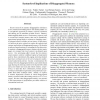Free Online Productivity Tools
i2Speak
i2Symbol
i2OCR
iTex2Img
iWeb2Print
iWeb2Shot
i2Type
iPdf2Split
iPdf2Merge
i2Bopomofo
i2Arabic
i2Style
i2Image
i2PDF
iLatex2Rtf
Sci2ools
HPCA
2012
IEEE
2012
IEEE
System-level implications of disaggregated memory
Recent research on memory disaggregation introduces a new architectural building block—the memory blade—as a cost-effective approach for memory capacity expansion and sharing for an ensemble of blade servers. Memory blades augment blade servers’ local memory capacity with a second-level (remote) memory that can be dynamically apportioned among blades in response to changing capacity demand, albeit at a higher access latency. In this paper, we build on the prior research to explore the software and systems implications of disaggregated memory. We develop a software-based prototype by extending the Xen hypervisor to emulate a disaggregated memory design wherein remote pages are swapped into local memory on-demand upon access. Our prototyping effort reveals that low-latency remote memory calls for a different regime of replacement policies than conventional disk paging, favoring minimal hypervisor overhead even at the cost of using less sophisticated replacement policies. Second, w...
Distributed And Parallel Computing | HPCA 2012 | Prototyping Effort | Sophisticated Replacement | Xen Hypervisor |
| Added | 24 Apr 2012 |
| Updated | 24 Apr 2012 |
| Type | Journal |
| Year | 2012 |
| Where | HPCA |
| Authors | Kevin T. Lim, Yoshio Turner, Jose Renato Santos, Alvin AuYoung, Jichuan Chang, Parthasarathy Ranganathan, Thomas F. Wenisch |
Comments (0)

